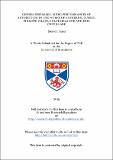Files in this item
Genres instables : ludic performances of autofiction in the works of Catherine Cusset, Philippe Vilain, Chloé Delaume and Éric Chevillard
Item metadata
| dc.contributor.advisor | Hugueny-Léger, Élise | |
| dc.contributor.advisor | Hutton, Margaret-Anne | |
| dc.contributor.author | Fraser, Morven | |
| dc.coverage.spatial | 228 p. | en_US |
| dc.date.accessioned | 2015-08-25T14:21:36Z | |
| dc.date.available | 2015-08-25T14:21:36Z | |
| dc.date.issued | 2015-11-30 | |
| dc.identifier.uri | https://hdl.handle.net/10023/7325 | |
| dc.description.abstract | Autofiction has been the subject of much critical investigation in France, yet little of this theory extends to contemporary texts. Furthermore, autofictional theory has, until now, neglected the study of ludic performance – an important feature within the genre –, and this thesis contributes to filling this gap in criticism. Through this analysis, I establish the genre’s construction as well as the constitution of the autobiographical persona in the autofictional texts of four authors. I argue that in order for autofiction to be considered as a genre, ludic strategies and autofictional personae are critical factors in the genre’s construction. I build on previous scholarship of autofiction before discussing the performance of autobiographical personae producing an autofictional body in the works of four contemporary French writers: Catherine Cusset, Philippe Vilain, Chloé Delaume and Éric Chevillard. Each author is analysed in a dedicated chapter exploring their autofictional œuvres, yielding three key trends. These are: the proliferation of intertextual references, ludic representations of the genre, and the creation of an autofictional body by the reader through autofictional personae. In each chapter I examine the construction of these personae, revealing a separation between selfhood constructed in language and questions of the body, both of the autofictional personae as well as characters within the text. Other characters within the texts expose complex constructions of gender that range from a rejection of male characters to the homogenisation of female characters reduced to stereotypes. Depictions of the intimate sphere within autofiction, including relationships and gendered constructs, are analysed in order to situate autofiction as a genre. Through the discussion of autofictional personae pivotal in this conception of autofiction, this thesis posits that representations of the body – within and beyond language – are the key to understanding autofictional performances. | en_US |
| dc.language.iso | en | en_US |
| dc.publisher | University of St Andrews | |
| dc.subject | Autofiction | en_US |
| dc.subject | Genre | en_US |
| dc.subject | Ludic | en_US |
| dc.subject | Performance | en_US |
| dc.subject | Delaume | en_US |
| dc.subject | Chevillard | en_US |
| dc.subject | Cusset | en_US |
| dc.subject | Vilain | en_US |
| dc.subject | Gender | en_US |
| dc.subject | Body | en_US |
| dc.subject | Intertextuality | en_US |
| dc.subject | Stereotypes | en_US |
| dc.subject | Selfhood | en_US |
| dc.subject.lcc | PQ637.A96F8 | |
| dc.subject.lcsh | Autobiographical fiction | en_US |
| dc.subject.lcsh | Delaume, Chloé, 1973- | en_US |
| dc.subject.lcsh | Chevillard, Éric | en_US |
| dc.subject.lcsh | Cusset, Catherine, 1963- | en_US |
| dc.subject.lcsh | Vilain, Philippe | en_US |
| dc.title | Genres instables : ludic performances of autofiction in the works of Catherine Cusset, Philippe Vilain, Chloé Delaume and Éric Chevillard | en_US |
| dc.type | Thesis | en_US |
| dc.contributor.sponsor | Gapper Foundation | en_US |
| dc.contributor.sponsor | University of St Andrews. School of Modern Languages | en_US |
| dc.type.qualificationlevel | Doctoral | en_US |
| dc.type.qualificationname | PhD Doctor of Philosophy | en_US |
| dc.publisher.institution | The University of St Andrews | en_US |
This item appears in the following Collection(s)
Items in the St Andrews Research Repository are protected by copyright, with all rights reserved, unless otherwise indicated.

